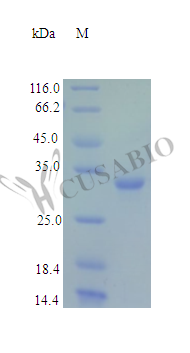To generate a recombinant human fructose-2,6-bisphosphatase TIGAR protein in E. coli, the full-length human TIGAR gene is inserted into an expression vector containing a C-terminal TAT-tag. The recombinant plasmid is then transformed into E. coli cells for protein production. Following expression, the cells are harvested, and the recombinant TIGAR protein is purified the cell lysate. The purity of the recombinant TIGAR protein exceeds 96% as determined by both SDS-PAGE and HPLC analysis. The activity of the recombinant TIGAR protein is assessed by its ability to protect U2OS cells from apoptosis induced by hydrogen peroxide. After pretreatment with the purified rHuTIGAR-TAT protein for 4 hours, the concentration range of 0.1-5.0 μg/ml demonstrates this recombinant TIGAR protein's efficacy in preserving cell viability. Its endotoxin is less than 1.0 EU/μg as determined by the LAL method.






